As one of the top trends in the health and tech industries today, human robotic exoskeletons are reshaping our approach to both medical treatment and industrial labor. On one hand, robotic exoskeletons are bringing hope to people across the world who are dealing with the loss of mobility and independence or suffering from paralysis after a stroke, brain injury, or spinal cord injury. On the other hand, they are enhancing worker capabilities beyond what was previously thought possible. Considering the nature of their advantages, it shouldn’t come as a surprise that they are also being used in military research and development.
What are Human Robotic Exoskeletons?
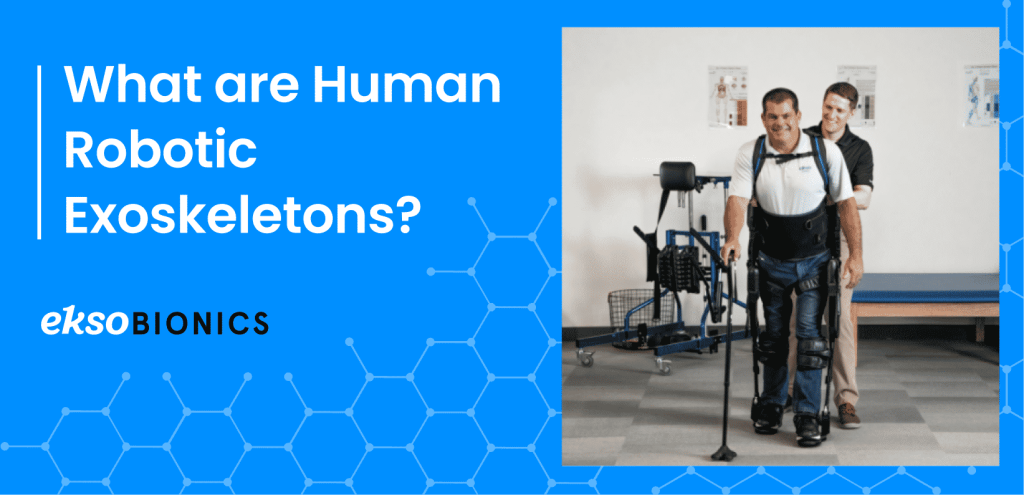
Human robotic exoskeletons are mechanically made, taking a user’s anatomy into consideration, to improve mobility and endurance. They involve the application of robotics and bio-mechatronics — a study of science that merges biology with “mechatronics”, a discipline at the crossroads of electronics, mechanics, and computing. The focus of this groundbreaking technology is to increase bodily independence and effectiveness. It is designed to assist humans by enhancing, reinforcing, or restoring, depending on the circumstances, an individual’s physical performance. Human robotic exoskeletons can also work to reduce the energy it takes to move joints, making repetitive tasks easier, and also work to improve human movement in cases of mobility loss.
The earliest work related to human robotic exoskeletons was much earlier than you might think. A Russian inventor named Nicholas Yagn had the first approved patent for a powered exoskeleton in 1890. It was a spring-operated device designed for the military with the intention of enhancing a user’s ability to run and jump, but it never made it past the drawing board.
It wasn’t until the 20th century that robotic exoskeletons were actually assembled. In 1960, General Electric created the Hardiman, or “Human Augmentation Research and Development Investigation” and “MANipulator”, a 1,500-pound machine produced with military funding. Unfortunately, the machine was too large and too heavy to operate properly and the project was discarded altogether.
Finally, around the year 2000 came BLEEX (Berkeley Lower Extremity Exoskeleton), a pair of robotic legs designed by engineers at UC Berkeley and funded by DARPA (Defense Advanced Research Project Agency) aimed at lessening the effort it takes to carry heavy loads over long stretches.
Today, robotic exoskeletons have become more prevalent and complex, with an array of functions and uses. Companies like Ekso Bionics have designed exoskeletons for the purpose of military research, assisting industrial labor, and aiding neurorehabilitation.
Components of Human Robotic Exoskeletons

Robotic exoskeletons made for humans may look different depending on the functions they serve. Exoskeletons can be made from materials such as carbon fiber, metal, and elastic. Their coverage also varies from the entire body, to lower or upper extremities, or to a specific body part like the shoulder, hip, or ankle. Some exoskeletons have adjustable hardware so they can be tailored to the individual that is using them. Overall, the technology behind the exoskeleton depends largely on its type and function.
There are two types of exoskeletons: powered and passive.
Powered exoskeletons are equipped with electronics that register how much force is being applied to any given action, allowing the exoskeleton to share some of that burden with the user. In order for the exoskeleton to work properly, there must be technologies to support the three modules: sense, decision, and execution. These technologies include sensors, actuators, mechanical structures, algorithms, and control strategies that gather necessary information for carrying out each action. It may sound complicated, but it’s actually fairly straightforward. There are three basic steps that accompany the three modules.
- The sense module is where the information gathering takes place. The exoskeleton records data from the user via the device sensors.
- Next, the decision module interprets that data and sorts it into the intended activities.
- Finally, the execution module provides the mechanical power to complete the task.
Examples of the lower-extremity powered exoskeleton at Ekso Bionics:
- Data capture
This feature allows the user to view session-specific walking time, distance, and speed. It also securely saves this information into a cloud-based dashboard for easier analytics.
- Clinician control:
This feature allows the clinician to set certain parameters they can use to help better assist their patient, ushc as training targets and step parameters.
- Smartassist software:
This feature allows the clinician to customize motor support independently on each leg for various impairment levels, from full assistance to patient-initiated movement, in both swing and stance phases of walking.
- Adaptive gait training:
This feature consists of sensors and software continuously monitoring and regulating leg movement to minimize compensatory gait patterns.
- Pre-ambulatory tools:
The feature possesses a program suite called preGait that consists of programs that help patients balance, weight shift, squat, and step in place before walking.
To contrast with the lower-extremity exoskeleton, here are the features of the upper-extremity exoskeleton vest for construction at Ekso Bionics:
- Mobility Structure
The exoskeleton vest was built with a patented stacked-link structure that seamlessly follows the user’s arm and elbow through the full range of motion while providing proper joint alignment through repetitive movement.
- Extreme logistics positions
These positions include reaching directly overhead, across the body, or even into a back pocket for a phone — are unrestricted with this wearable exoskeleton.
- Adjustable, high-force actuators
These actuators are proven to be extremely durable with over a million cycles before requiring replacement.
- Customized Assistance Levels
The level of each device can be adjusted for the user and task by easily swapping out the set of compact gas springs. Different levels can even be selected for each arm independently depending on the task.
Passive exoskeletons are purely mechanical, providing support using pulleys, a spring balancer, and weights to counterbalance the workload. Passive systems generally take the weight off the user’s shoulders and arms and transfer it to their center of gravity so that the user obtains increased endurance during overhead tasks and other demanding work.
Exoskeleton technology not only helps the individual perform tasks that directly aid in increasing mobility, but also provides medical professionals with the information needed to offer treatment with a higher chance of success. For patients with a low likelihood of regaining their mobility, these machines can be a saving grace, in many cases enabling full rehabilitation.
Exoskeletons for Rehabilitation
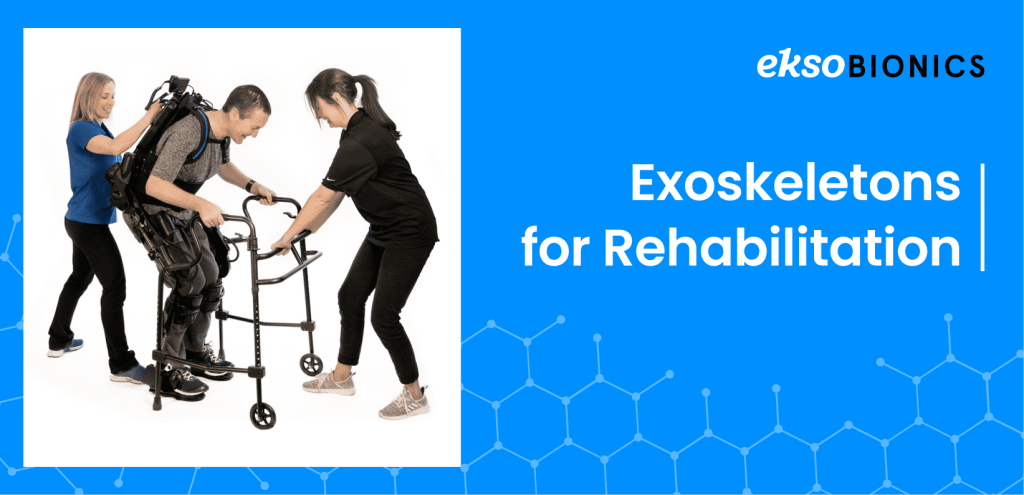
Diseases or injuries that can be treated with physical therapy and a wearable exoskeleton include but are not limited to: stroke, spinal cord injury, traumatic brain injury, aneurysm, hypoxia/anoxia, ischemia, brain tumor, or any other acquired brain injury. For individuals recovering from these injuries, exoskeletons are great for rehabilitation and mobility restoration. Exoskeletons have the potential to bring these patients from lower limb disability and complete loss of movement all the way to the point of getting out of their wheelchairs, and learning to walk again. One study from 2015 found that, “The ability to restore gait for individuals with paraplegia has improved with progress in various powered exoskeletons and neuromuscular stimulation technologies. The powered exoskeletons are able to restore the stand up, sit down, and walking motions.” These human-augmenting devices are truly a rehab tool for physical therapists to challenge their patients, requiring active participation known to drive brain plasticity.
Exoskeletons for Upper Extremity Therapy
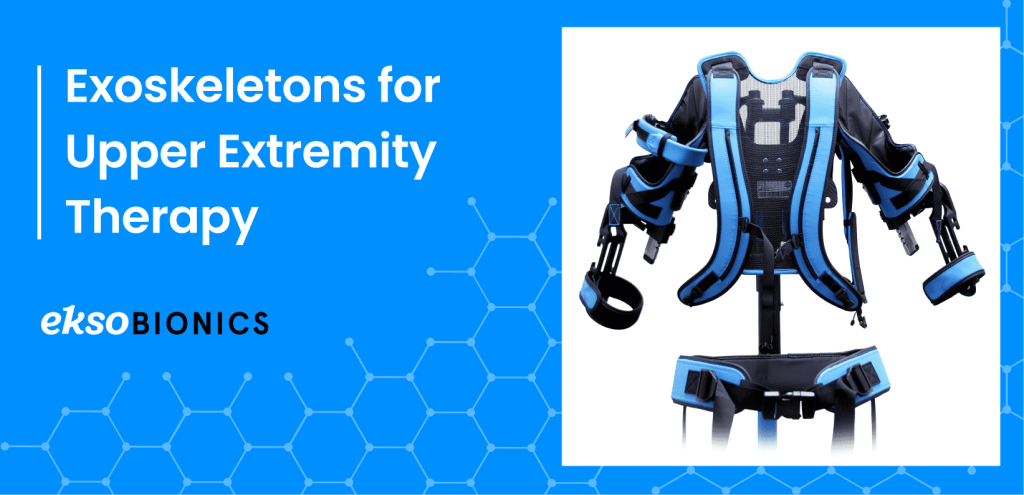
Upper-extremity rehabilitation exoskeletons assist physical therapists, occupational therapists, physiatrists, and doctors in clinically rehabilitating patients with upper-body weakness or paralysis. This new technology also greatly benefits industrial applications and other workplace settings or job sites. Wearable exoskeletons help workers complete tasks with full range of motion rather than giving in to fatigue, overuse, or repetitive movements.
An injury resulting in decrease of upper-body strength can come from any number of areas whether that be occupation risks, sport injury, or illness. An upper-body exoskeleton is a wearable vest that helps you perform everyday tasks and use your arms and shoulders without limitations. There are a few different reasons why someone may benefit from upper-extremity therapy and bionics. Some conditions EksoUE is beneficial for include: stroke, spinal cord injury, traumatic brain injury, muscular dystrophy, ataxia, orthopedic injury, Guillain barre, brain tumor, brachial plexus injuries, and other upper-extremity weakness or paralysis. Rehabilitative treatments may begin immediately post-injury or after any chance of reversing the damage through medical means has passed. These treatments are designed to strengthen weakened muscles, reteach parts of the brain to take over for the damaged areas, and help the patient adapt to a new way of doing things.
Exoskeletons for Lower Extremity Therapy
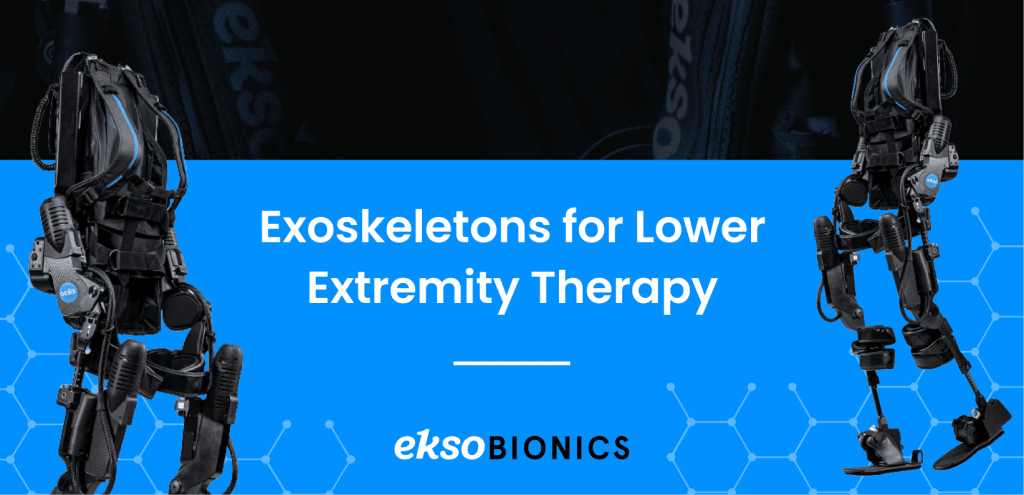
Exoskeletons for lower extremity therapy are appropriate for many people recovering from spinal cord injury, stroke, and brain injury at any stage of in-patient or outpatient rehabilitation, preferably as soon as possible after diagnosis. It can be helpful for patients to stand and take their first steps post-injury and retrain brain and muscle function as they learn to walk again. It can also help fine-tune walking skills and help improve patients’ gait as they learn to regulate their movements.
With this tool, patients have the opportunity to gain as many lost abilities as possible. The exoskeleton provides progressive levels of support so the clinician can reduce the assistance the system offers patients as they improve, and can even add resistance to one or both legs. Patients who use a wheelchair can use the exoskeleton to regain the ability to stand, retraining muscles to support body weight without strain. Therapists toggle between patient-initiated and therapist-initiated movement, tailoring rehabilitation to the patient.
Human Robotics for Industrial Labor
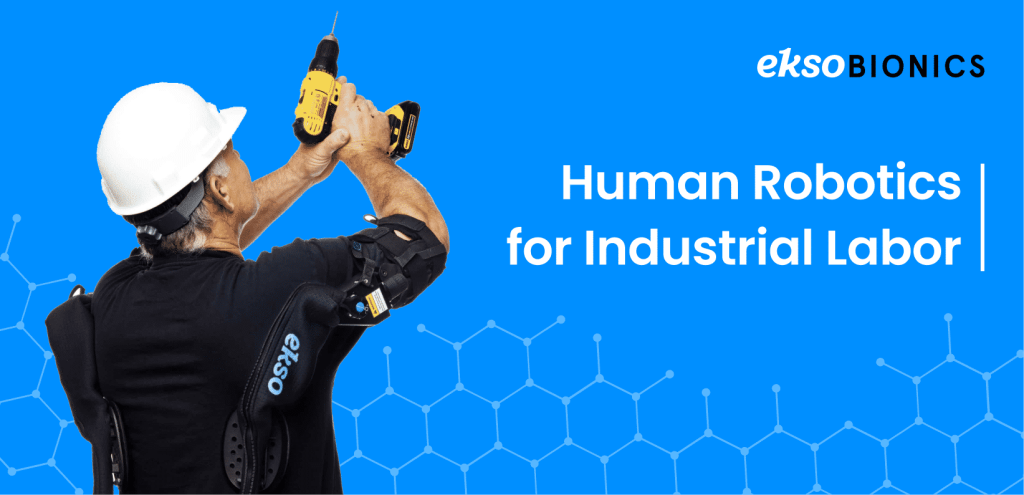
Industrial workers in construction or manufacturing benefit from a significantly lower likelihood of injury and increased quality of work by using exoskeletons to enhance their physical capabilities. Mechanical arms and vests help them lift heavy loads and perform repetitive tasks through an active range of motion so they can avoid giving in to fatigue and/or injury.
Why Choose Ekso Bionics for Human Robotic Exoskeletons?
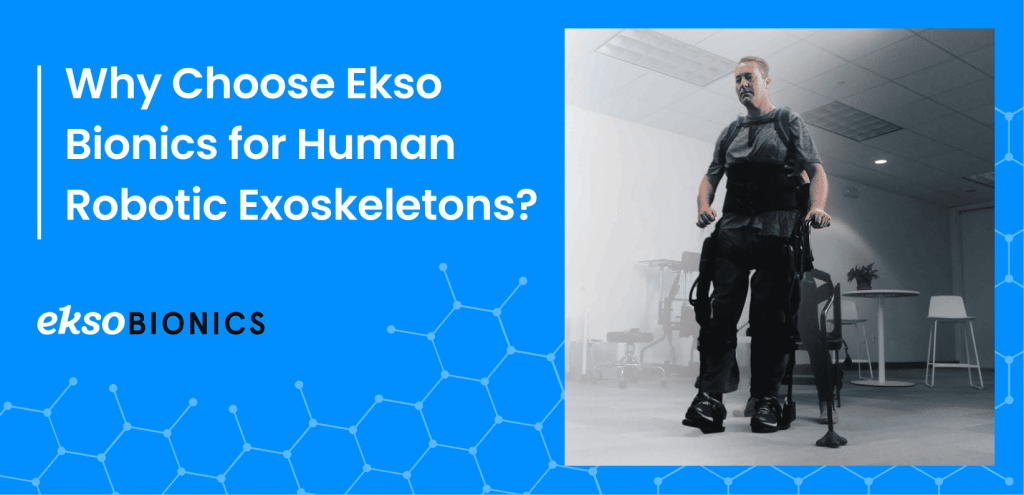
Ekso Bionics is the leader in exoskeleton technology with the first FDA-cleared exoskeleton for both stroke and SCI in addition to acquired brain injury. With more than 175 conference presentations, chapters, and published articles, Ekso is the most widely-studied exoskeleton for rehabilitation, progressing patients far beyond what they would otherwise be able to accomplish. Our exoskeletons are backed by data from over 40 industry-leading research partners and help those with paralysis to stand up and walk, enhance worker capabilities globally, and provide research for the advancement of R&D projects intended to benefit U.S. defense capabilities.
Industries Ekso Bionics Specializes In

EksoHealth is the arm of Ekso Bionics that specializes in neurorehabilitation. We have helped thousands of patients with lower extremity disabilities take over 180 million Ekso-aided steps and have inspired an entirely new medical device industry. Similarly, we have helped many patients with upper extremity disabilities, allowing them to achieve rehab sessions with a higher dosage, more intense therapy, and a wider active range of motion.
EksoWorks is the arm of Ekso Bionics that specializes in our exoskeleton technology for industrial applications. Our EksoWorks upper-body lifting exoskeletons were designed to increase productivity and reduce fatigue, with the goal of eliminating work-related injuries to the neck, shoulder, and back.
Conclusion
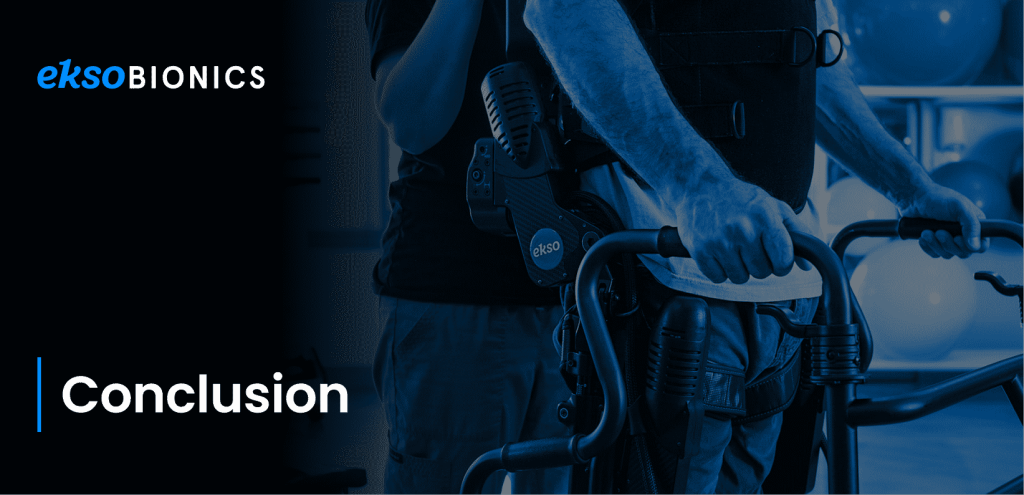
Whether you’re looking to regain mobility, increase your capabilities on the job, or prevent injuries, human robotic exoskeletons are a reliable and technologically safe choice. We hope our exoskeletons provide you support and progress in rehabilitation and lower the number of worker-related injuries for years to come.